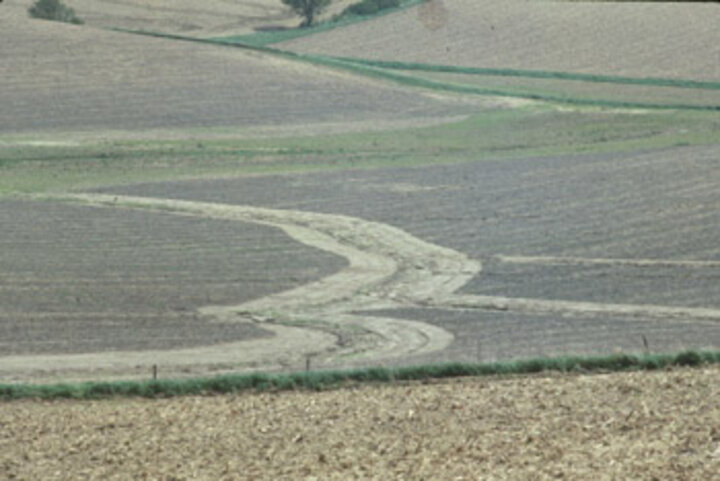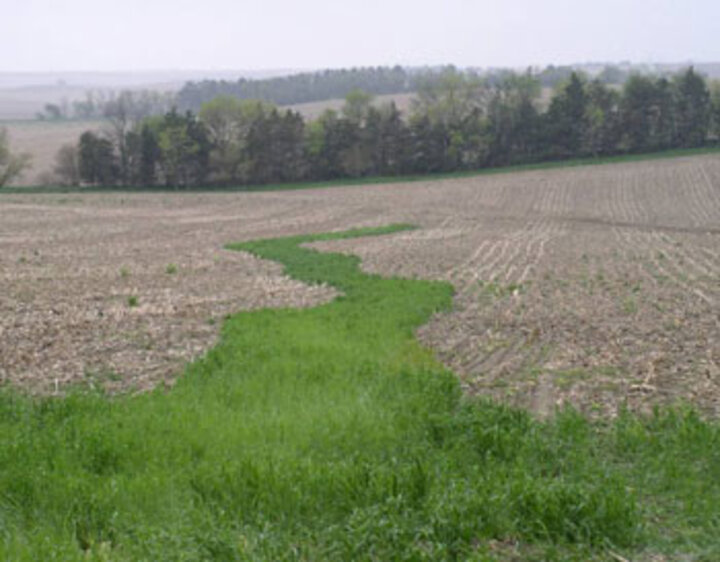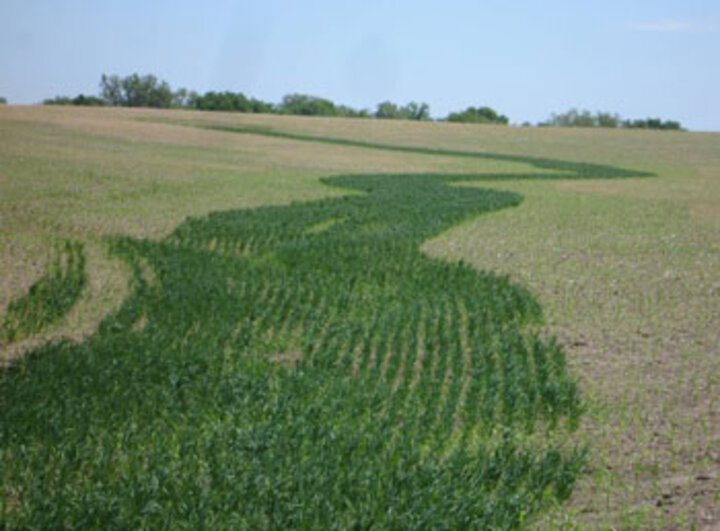November 7, 2014



With the intense rains this past season, some areas of the state had considerable gully erosion cutting up the fields, bounced across and made visible at harvest time, especially in soybeans. Some occurred in hailed out fields where there was no crop canopy to absorb the energy of the falling rain. While your first impulse may be to till in the gullies, take a moment to examine why they formed where they did. Were they caused by:
- field runoff due to high rainfall rates or a lack of infiltration?
- concentrated flows from another area coming into the field?
- water concentrating in a wheel track, furrow, or end row?
- soil crusting because of a lack of soil cover due to tillage or hail?
Each of these causes needs a slightly different treatment to reduce the chance of the gully forming again (Figure 1).
Causes
Field Runoff Gullies. Usually gullies from field runoff form in the same place year after year, especially in tilled fields. Tillage destroys soil structure and reduces the residue cover, leaving the soil surface more prone to erosion and runoff. While the tillage does fill in the gully, each time the gully washes out again, the soil is lost from the gully and from along the sides of the gully as that soil was used to repair the gully. Rather than repairing the gullies every year, use terraces to intercept the runoff and grass waterways or underground tile lines to carry the runoff from the field without causing more erosion. These terraces and waterways or tile lines need regular maintenance to keep them functioning properly so they can handle heavy rainfall events.
Producers can keep more water in their fields by improving soil structure with continuous no-till and leaving residue on the soil surface to reduce crusting. This allows more water to be infiltrated into the soil, decreasing runoff and reducing the formation of rills and gullies. While no-till and residue management are fairly effective at reducing sheet and rill erosion, gully erosion can still take place when concentrated flows exist. Whenever rainfall rates exceed infiltration rates, especially on saturated soils, other runoff control methods may still be needed to carry the water away safely.
Concentrated Water Flows. Gullies are caused by concentrated flows, either from field runoff and small rills combining together into larger flows or from runoff coming onto the field from a concentrated source. Examples include water from a road culvert dumping into a field, runoff from farmsteads or other areas with reduced infiltration, from terraces over-topping because of reduced carrying capacity, or from field runoff from many crop rows combining together on end rows, especially when end rows are planted next to a waterway and the runoff cannot enter the waterway.
Treatments
Grassed Waterways. When concentrated flows exist, the soil needs extra protection to keep it from washing away. A permanent grassed waterway will help protect and anchor the soil. The waterway should be sized to handle maximum flows and field operations should go into the waterway so water can flow into the grassed area. End rows should not be planted along side a waterway because that will hinder water flow into the waterway. (NRCS can help with the technical design, sizing, and layout of grassed waterways.) The waterways need periodic maintenance to keep them functioning properly and care must be taken with herbicide applications so as not to damage the grass stands.
Annual Cover Crops. While grassed waterways are fairly effective in handling concentrated flows, many producers don't like to take land out of crop production with waterways. In no-till where there is reduced runoff many producers are using annual cover crops to replace permanent grassed waterways. Any gullies in the concentrated flow areas are filled in and shaped after harvest and then a fall cover crop such as cereal rye is seeded (Figure 2). In addition to the residue produced and the improved soil structure, the cover crops provide roots to anchor the soil and dissipate the energy of the flowing water, particularly in the off season when the regular crop isn't growing. If harvest is late and there isn't enough time to establish a fall seeded cover crop, an early spring cover crop such as oats could be seeded and growing by the time the spring thunderstorms occur (Figure 3). When herbicides are applied to the next cash crop, the cover crop is killed and the roots and residue are left behind to help protect the soil. The next crop adds to the roots and canopy to further reduce the chance of erosion. After the next harvest, another cover crop is planted in the flow areas to keep the soil anchored and protected.
Summary of Treatment Options
Producers need to fill in and shape gullies as they form to reduce additional erosion and maintain farmability. However, unless they anchor and protect the soil, the repaired gullies will typically wash back out, often to the depth of tillage. A permanent grassed waterway should be used to handle concentrated flows where gullies continue to form year after year. In no-till production systems, annual cover crops may be used instead to help protect the soil without taking land out of production. The key is to grow something in those areas so that the vegetation slows the runoff and the roots anchor the soil, dissipating the erosive forces of the flowing water.
Paul Jasa
Extension Engineer
